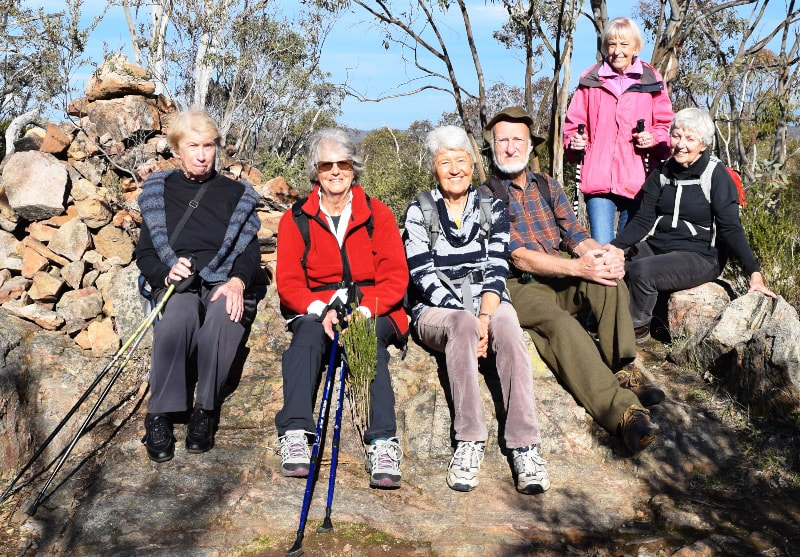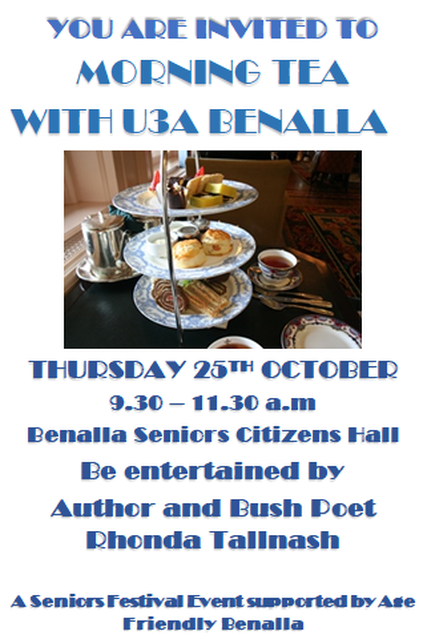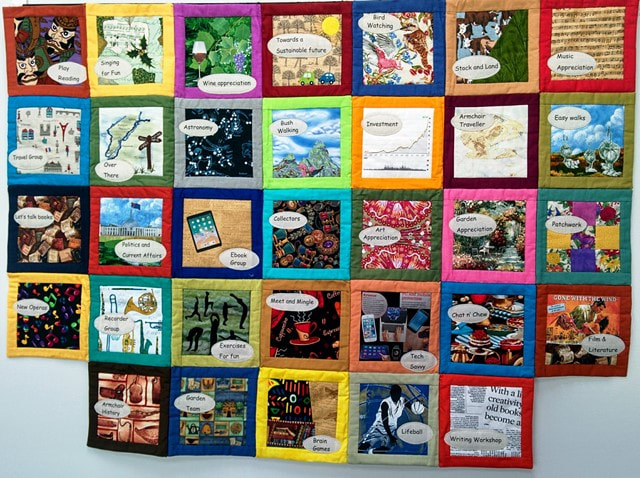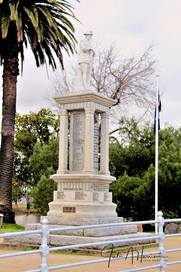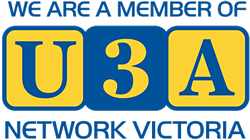|
Festive table cloths, flowers, a delicious morning tea & an engaging presentation of bush poetry by Rhonda Tallnash - an excellent way to celebrate Seniors Month! The following article appeared in the 'Adult Learner's Week' lift out in the Ensign on 22 August. The U3A movement is a volunteer organisation providing education, creative and leisure opportunities in a friendly environment for retired and semi retired and semi retired members of the community.
Benalla U3A has a room within the seniors building complex, which is used every day of the week for one or more programs. It also runs activities at the art gallery (Art Appreciation), Benalla Leisure Centre (Lifeball) and the library (eBooks and Let's Talk Books), as well as bird watching, visits to wineries in the district and garden visits. U3A's 'Chat n Chew' activity is one of their most popular, having lunch at a different local eatery once a month. Benalla now has 289 members, many of whom come and go through the year, after all, we are retired and holidays and family visits are an important part of life. It is one of 109 U3A groups representing 37,000 members across Victoria. The U3A Newsletter is delivered by email or post each month to keep the public up to date with what is happening. Benalla U3A is happy to welcome new members. So don't be shy, come and join in, make your retirement years full of learning and friendship, meet new people and enjoy what U3A Benalla has to offer. U3A Benalla is a participant in the nationally funded Be Connected program. This week is Be Connected's 'Get On-Line Week', with older people being encouraged By Be Connected to '#try1thing'. Our President, Dorothy, '#tried1thing' recently! Dorothy added her credit card to her mobile phone so she can use it when making transactions. Dorothy offered to share with us how she learnt to do this. Be Connected members brought along their devices and tried out Stocard with Dorothy's support. Bev also demonstrated the Google Home Assistant to lots of laughs. A delicious afternoon tea was followed by a group photo - with a little time left over for work on 'Be Connected' on line learning modules assisted by our mentors. Inspired by the Patchwork group, showcasing the creativity of patchworker Heather Sloane and featuring contributions from various patchworkers' 'stashes' of materials, our eyecatching new banner now graces and enlivens the U3A Meeting Room at the Benalla Senior Citizens Community Centre. It is a wonderful conversation starter. Thank you so much Heather for developing such wonderful concepts in fabric for each of our groups!
The Taungurung (Daung wurrung) people occupy much of central Victoria. Our country encompasses the area between the upper reaches of the Goulburn River and it’s tributaries north of the Dividing Range. From Kilmore in the west, eastwards to Mount Beauty, Benalla in the north and south to the top of the Great Dividing Range and boundaries with adjoining Aboriginal tribes are respected in accordance with traditional laws. Traditionally, our people lived a hunter/ gatherer existence. The various clan groups migrated on a seasonal basis through their territory dependent upon the seasonal variations of weather and the availability of food.
The Taungurung people are closely affiliated with the neighboring tribes, through language, ceremonies and kinship ties. We are part of an alliance with the five adjoining tribes to form the Kulin Nation. Other members of the Kulin Nation are the Woiwurrung, Boonwurrung, Wathaurung, and Djadjawrung. The Kulin Nation group shared common dreamtime ancestors and creation stories, religious beliefs, economic and social relationships. The Taungurung Legacy The Taungurung people shared a common bond in moiety affiliation with the other tribes. Their world was divided into two moieties: Waang (crow) and Bundjil (wedge tail eagle). Members of the tribe identified with one or the other of these moieties and it was their moiety which determined the pattern for marriage between individuals, clans and tribes and transcended local allegiances by obliging clan members to find spouses from some distant clan of the opposite moiety, either within or outside their own wurrung (language group). The Taungurung people consisted of nine clans. The Buthera Balug was located on the Upper Goulburn, as far down as Yea and Seymour. The Look Willam roamed the area on the Campaspe River, near Kilmore. The Moomoom Gundidj lived west of the Campaspe River, and northwest of Mitchellstown. The Nattarak Balug lived on the Coliban River and upper Campaspe River while the Nira Balug ‘Cave People’ bordered the Woiwurrung at the Great Dividing Range, and lived on creeks and hills near Kilmore, Broadford, Pyalong and westward towards Mt Macedon. The Warring-Illum Balug, (Warring being the name for the Goulburn River), lived on the Upper Goulburn River, at Yea and Alexandra and the Yarran-Illam were located on the east side of the Goulburn River, below Seymour. The Yeerun-Illam-Balug inhabited the area around Benalla and the Yowung-Illam- Balug lived at Alexandra, Mansfield and the Upper Goulburn River. Sadly there are descendants of only five of those clan groups that survive today. The nomadic nature of the Taungurung people enabled the people to utilise the resources available in their vast country. Our ancestors had an intimate knowledge of their environment and were able to sustain the ecology of the each region and exploit the food available. A staple plant food was the mirniong (yam daisy) which provided a reliable source of carbohydrate. Other plants such as the bracken fern (food and medicine), the tree fern, kangaroo apple and cherry ballart were a valuable food source and can still be seen growing on Taungurung country today. Wangnarra (stringybark) was used to construct yilam (shelters) or to weave benak (baskets). Fibrous plants, such as buarth (tussock grass) were produced burrt-tean (twine) for garrt-girrk (nets) while other tree species were utilised for their timber to fashion malgarr (shields), gudjerrun (clubs), wangim (boomerangs), darnuk (water carriers) and gurrong (canoes). The rich resources of the permanent rivers, creeks and tributaries and associated floodplains enabled the Taungurung to have an abundance of fish and other wildlife. Fish were speared and trapped while water birds netted and the mirrm (kangaroo), gorbil (koala), and barraimal (emu) provided nourishing food. The pelts from the walert (native possum) were sewn together to form googarra ( cloak ) ideal for the often cold and wet conditions. Plants such as kurrajong provided fibers to weave garrt-girrk (nets) for harvesting the nutritious deberer (Bogong moth) in the summer. Taungurung would travel south during the deberer season and head northwards when the weather cooled. When Europeans first settled the region in the early 1800s, the area was already occupied by Aboriginal people. From that time, life for the Taungurung people in central Victoria changed dramatically and was severely disrupted by the early establishment and expansion of European settlement. Traditional society broke down with the first settlers arrival and soon after, Aboriginal mortality rates soared as a result of introduced diseases, denial of access to traditional foods and medicines and conflict. At various times, Aboriginal settlements were established in the area by missionaries and governments at Michellstown, Acheron and Coranderrk however despite relative success were eventually dissolved through various government policies. The Taungurung and other members of Kulin Nation were deeply impacted by the dictates of the various government assimilation and integration policies. Today, the descendants of the Taungurung form a strong and vibrant community. Descendents of five of the original clan groups meet regularly at Camp Jungai—an ancestral ceremonial site. Elders assist with the instruction of younger generations in culture, history, and language and furthering of their knowledge and appreciation of their heritage as the rightful custodians of the Taungurung lands in Central Victoria. Evidence of the Taungurung can be found in many places throughout Taungurung Country. Scar trees, rock shelters, rock art and even place names all indicate that we have been in this part of Victoria for thousands of years. While travelling through Taungurung lands you will be aware of the following towns. All these towns have a Taungurung origin. Benalla—benalta=big waterhole Delatite—Delotite, wife of Beeolite, clan head of the Yowung-illam-balluk clan, Murrindindi—murrumdoorandi = place of mists, mountain Trawool—trawalla = wild water, Nagambie—nogamby = lagoon. Many Taungurung people still live on their country and participate widely in the community as cultural heritage advisors, land management officers, artists and educationalist and are a ready source of knowledge concerning the Taungurung people from central are of Victoria. We are pleased to welcome you to our country—to enjoy the landscapes, the flora and fauna. The Taungurung will continue to care for this country and welcome those who share a similar respect. Taungurung - A Brief History by Loraine Padgham September 2011 Originally Published in Taungurung Times http://taungurung.net/2011/04/taungurung_a_brief_history.html Benalla & District Anzac Commemorative Committee Invites you to
A Concert of Songs Celebrating 100 years since the end of the Great War performed by Benalla Theatre Company and the U3A Choir 11 November 2018 2.30 pm Benalla Town Hall Nunn Street, Benalla An Ecumenical Church Service to commemorate 100 Years since the end of the Great War and to honour those who have served in all of Australia's wars 11 November 2018 7.30pm St Joseph's Catholic Church Arundel Street, Benalla Light Supper to Follow An Exhibition of Memorabilia from the Great War to commemorate 100 years since the end of that War 24th October to 12 November Sir Edward 'Weary' Dunlop Learning Centre Fawckner Drive, Benalla Open During Library hours |
News updateThis page is for 'general' news - some will be 'just in' news notices of changes to timetables or news of meetings; other items will be celebratory, some will be sad, there will be some longer news items on topics of interest. ContributionsContributions and suggestions can be sent via the 'Contact Us' form or by emailing or telephoning the web manager on 5762 8171.
Course SuggestionsA Program Suggestions page is available for your course ideas and suggestions.
Local News LinksTopics
All
Archives
July 2024
|
- Home
- Benalla
- About
-
Groups
- Groups A - Z
- Recent Groups >
-
Archived Groups
>
-
A - M
>
- A Different View Of German History
- Armchair History (British)
- Armchair Traveller
- Booker Reading Group
- Bushwalking - Mid-week Walks
- Comparative Religion
- Facebook for Mentors
- German - Beginners
- Google Apps/TS Plus
- History - An Introduction to Western Civilization
- History - Moments in Australian History
- Hot Topics/The News - Fact or Fiction?
- Investment I (1996 -2015)
- Legal Matters (Short Course)
- Meditation
- Making the Most of the Internet
- O - Z >
-
A - M
>
- A - B
- C - E
- F-Pa
- Ph-W
- Join
- News
- FB
- Gallery
- Links
- Contact

